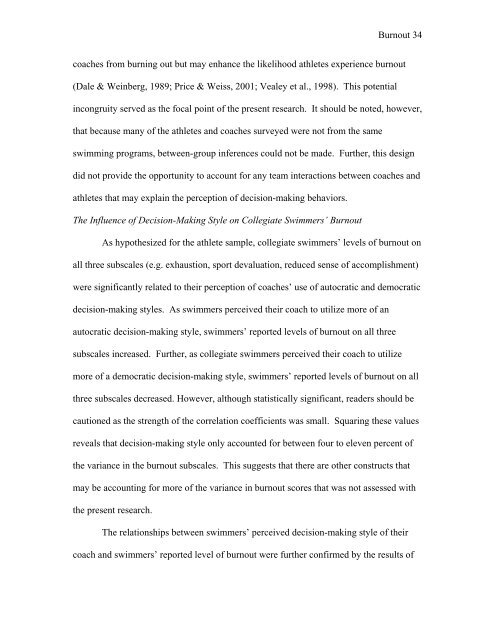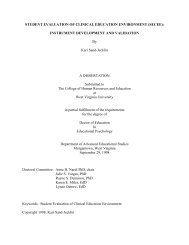Coach and Athlete Burnout - West Virginia University
Coach and Athlete Burnout - West Virginia University
Coach and Athlete Burnout - West Virginia University
You also want an ePaper? Increase the reach of your titles
YUMPU automatically turns print PDFs into web optimized ePapers that Google loves.
<strong>Burnout</strong> 34<br />
coaches from burning out but may enhance the likelihood athletes experience burnout<br />
(Dale & Weinberg, 1989; Price & Weiss, 2001; Vealey et al., 1998). This potential<br />
incongruity served as the focal point of the present research. It should be noted, however,<br />
that because many of the athletes <strong>and</strong> coaches surveyed were not from the same<br />
swimming programs, between-group inferences could not be made. Further, this design<br />
did not provide the opportunity to account for any team interactions between coaches <strong>and</strong><br />
athletes that may explain the perception of decision-making behaviors.<br />
The Influence of Decision-Making Style on Collegiate Swimmers’ <strong>Burnout</strong><br />
As hypothesized for the athlete sample, collegiate swimmers’ levels of burnout on<br />
all three subscales (e.g. exhaustion, sport devaluation, reduced sense of accomplishment)<br />
were significantly related to their perception of coaches’ use of autocratic <strong>and</strong> democratic<br />
decision-making styles. As swimmers perceived their coach to utilize more of an<br />
autocratic decision-making style, swimmers’ reported levels of burnout on all three<br />
subscales increased. Further, as collegiate swimmers perceived their coach to utilize<br />
more of a democratic decision-making style, swimmers’ reported levels of burnout on all<br />
three subscales decreased. However, although statistically significant, readers should be<br />
cautioned as the strength of the correlation coefficients was small. Squaring these values<br />
reveals that decision-making style only accounted for between four to eleven percent of<br />
the variance in the burnout subscales. This suggests that there are other constructs that<br />
may be accounting for more of the variance in burnout scores that was not assessed with<br />
the present research.<br />
The relationships between swimmers’ perceived decision-making style of their<br />
coach <strong>and</strong> swimmers’ reported level of burnout were further confirmed by the results of












